
|
How
can we restore St. Mary's Cemetery? A few months ago, Angelus Rosedale Cemetery and West Adams Heritage
Association, both of Los Angeles, teamed up to put on the "Living
History Tour 2003." It is a annual project and very successful.
Five of the "permanent" residents of the cemetery were selected.
Historical background research was done on each of the five. Volunteer actors
dressed in period costume at the five different grave sites of the chosen
five "permanent" residents. For about twenty minutes the actors
gave a talk about the lives of the persons buried underfoot. After about
an hour a half we had strolled through the cemetery and were filled
with the most interesting and informative history of Los Angeles and
it's pioneers. A one day event with around ten tours will attract
between 300-400 people. Tickets are sold out very quickly. The next
tour will be in October 2004. |
|
Living
History Tour 2003 Living
History Tour 2003 |
| CAST in order of appearance: Lyman Stewart / Stephen Heywood John H. Jones / Paul Brynen Robert Jones Burdette / James Carey Martha Bennett Swope / Anna Marie Brooks Cornelius Johnson / Rion Peavy |
| LYMAN STEWART 1840-1923 As a native of Pennsylvania, Lyman Stewart had ample opportunity to observe the development of the oil industry. "Oil seeps" were a common feature in the landscape, and the first oil well in the United States was drilled near Titusville. Steward invested his savings in drilling rights, but made no consistent profit. In 1883, he heard reports of potential oil fields in California available at low cost and decided to relocate. After four unsuccessful attempts, he finally struck oil near Newhall in the same year. By 1890, he and his partners had formed the Union Oil Company and were funding development of new drilling and refining methods. They were also seeking new uses for their products. But oil was only one of Srewart's interests. He had become increasingly involved in fundamentalist religion. He was one of the founders of the Union Rescue Mission, which distributed food, clothing and salvation to those in need. He also supported the Bible Institute of Los Angeles and the Church of the Open Door. These worthy organizations absorbed much of the profit he gained from oil, although they gave him great satisfaction. 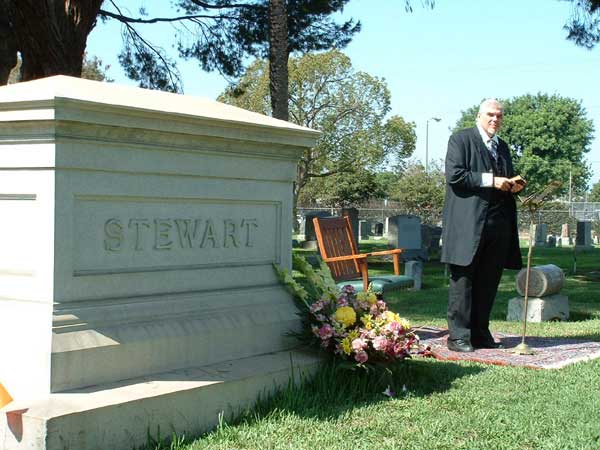
|
|
JOHN H. JONES
1834-1903 John Jones was the proverbial self-made man. He was born in New York State, and sailed around the horn of South America to seek his fortune in California in 1854. He worked for Don Abel Stearns as a coachman. Stearns was a New Englander who came to California in 1826 and who became a naturalized Mexican citizen. He was one of the largest landowners in Southern California. In the 1860s, Stearns lost much of his fortune after a severe drought killed most of his cattle. He borrowed money from Jones, who had saved his wages carefully. He also sold Jones land, which gave Jones a real start. John Jones was active in many types of business. He was willing to try anything, and he had great faith in the future of Los Angeles. This faith, and his efforts, was repaid a hundredfold, as Jones and his adopted city prospered together. He found it a small, sleepy town built of adobe, and left it a bustling financial metropolis. 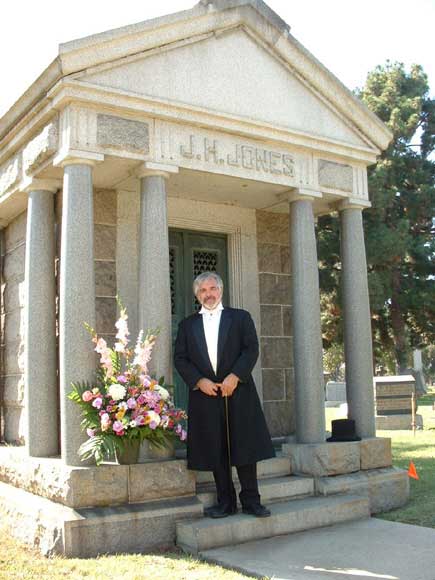
|
| ROBERT JONES BURDETTE 1844-1914 Robert Burdette was born in Pennsylvania but grew up in Illinois. His early life included experience as a Civil War soldier and as a Cuban Revolution blockade-runner. His career was journalism. His humorous columns for the Burlington Daily Hawk Eye earned this paper a national circulation. He extended his success to the lecture platform, where he was compared to his popular contemporary, Mark Twain. By 1888, he was still traveling the lecture circuit, but as a Baptist preacher. In 1907, he came to California and became the first minister at the Temple Baptist Church, where he contributed substantially to the popularity of that organization. He is remembered as "the physician of the merry heart." 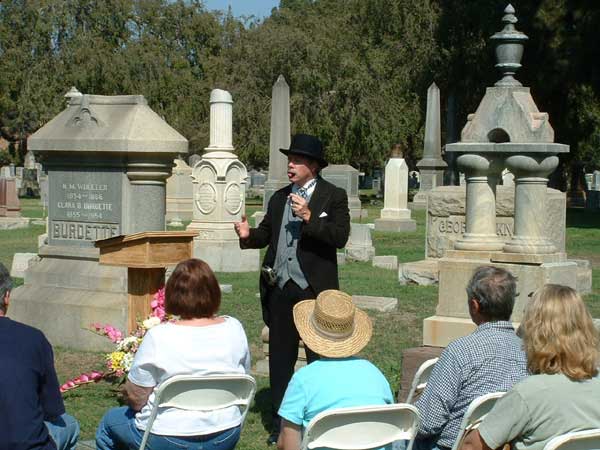
|
| MARTHA BENNETT SWOPE 1848-1910 When Asahel Bennett left Wisconsin in 1849 to seek gold in California, his wife Sarah and their children, George, aged 8, Melissa, aged 5, and Martha aged 2, came with him. They joined a wagon train at Salt Lake in October, 1849, but the group soon split up. The Bennetts were part of a small group that decided to take a route that was said to be shorter. The route proved to be a deception, and by December, they had lost the use of their wagons and were stranded in an area that they would aptly call Death Valley. There was water, but their food supplies were very limited. The tragedy of the Donner party was well known to the settlers. They collected what money they had, and sent their guides, William Manly and John Rogers, to travel through unmapped territory on foot. They hoped that the guides could reach a settled area and buy supplies, and return to rescue the rest of the party. After 26 days had passed, hope almost failed, but Manly and Rogers did return. They had made a 600-mile journey to fulfill their charge and rescue the entire party, including young Martha. 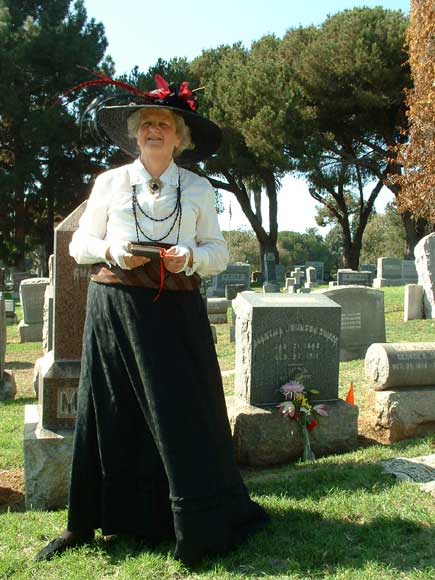
|
| CORNELIUS JOHNSON 1913-1946 Native Californian Cornelius Johnson showed athletic talent at a young age. He participated in track and field at Berendo Junior High School. As a freshman at Los Angeles High School in 1930, he cleared a high jump of 6'2" on his first day of practice. Encouraged by his coaches, he qualified for the 1932 Olympics in Los Angeles. In the 1936 Olympics in Berlin, he contributed to the U.S. succeeded by winning the gold medal for the high jump. He set an Olympic record of 6'8" in the sport. And if Adolph Hitler refused to congratulate him, it was Hitler's loss. Johnson did not join his Olympics teammate Jesse Owens in professional athletics. He continued to participate as an amateur. In 1945, he joined the Merchant Marine. The following year, he was taken ill while at sea, and died before he could be taken to shore. 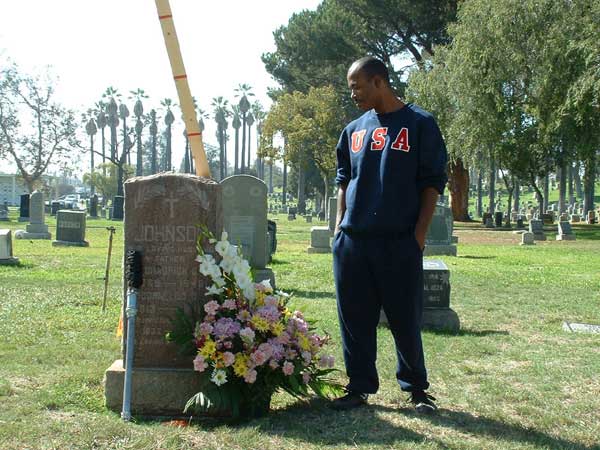
|
| West Adams Heritage Association Tour Organizing Committee Audrey Arlington, Lyn Gillson, Corinne Pleger, Cat Slater West Adams Heritage Association Volunteers Andy and Bill Burnside, Jean Cade, Alma Carlisle, Ken Catbagan, Frank and Suzanne Cooper, Arabella Davis, Tom Gracyk, Martha Graft, Don Henderson, Ron Jarman, Peggy King, Norma Latimar, Robert Leary, Hilary Lentini, Laurie McGee, Ryan McGee, Jim Meister, Mitzi Mogul, Dave Pleger, Lauren Schlau, Jaqueline Sharps, Steve Shaw, Lana Soroko, Sally Turner All proceeds benefit West Adams Heritage Association The West Adams Heritage Association is a nonprofit organization. If you are interested in becoming a member, fill out and return this application along with payment to: WAHA, 2263 South Harvard Blvd., Historic West Adams, Los Angeles, CA 900018, 323-735-WAHA (323-735-9242) Angelus Rosedale Cemetery 1831 W. Washington Blvd., Los Angeles, CA 90007 323-734-3155 |